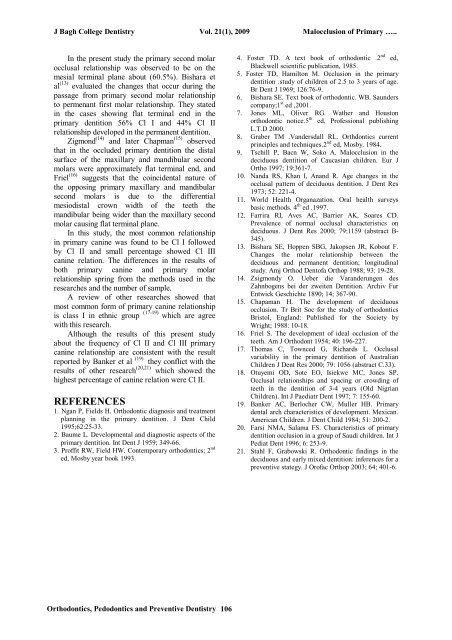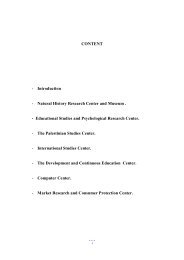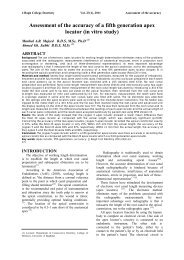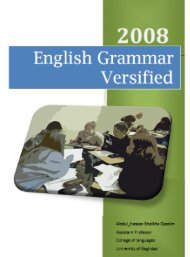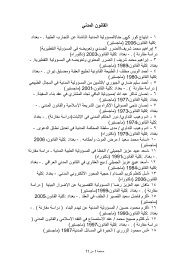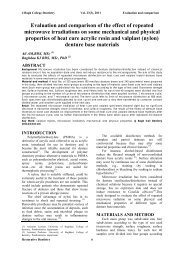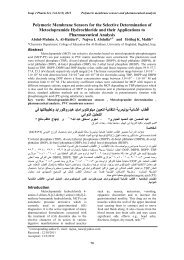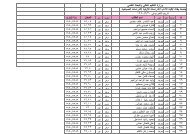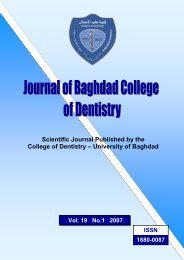Vol 21 No. 1
Vol 21 No. 1
Vol 21 No. 1
You also want an ePaper? Increase the reach of your titles
YUMPU automatically turns print PDFs into web optimized ePapers that Google loves.
J Bagh College Dentistry <strong>Vol</strong>. <strong>21</strong>(1), 2009 Malocclusion of Primary …..<br />
In the present study the primary second molar<br />
occlusal relationship was observed to be on the<br />
mesial terminal plane about (60.5%). Bishara et<br />
al (13) evaluated the changes that occur during the<br />
passage from primary second molar relationship<br />
to permenant first molar relationship. They stated<br />
in the cases showing flat terminal end in the<br />
primary dentition 56% Cl I and 44% Cl II<br />
relationship developed in the permanent dentition.<br />
Zigmond (14) and later Chapman (15) observed<br />
that in the occluded primary dentition the distal<br />
surface of the maxillary and mandibular second<br />
molars were approximately flat terminal end, and<br />
Friel (16) suggests that the coincidental nature of<br />
the opposing primary maxillary and mandibular<br />
second molars is due to the differential<br />
mesiodistal crown width of the teeth the<br />
mandibular being wider than the maxillary second<br />
molar causing flat terminal plane.<br />
In this study, the most common relationship<br />
in primary canine was found to be Cl I followed<br />
by Cl II and small percentage showed Cl III<br />
canine relation. The differences in the results of<br />
both primary canine and primary molar<br />
relationship spring from the methods used in the<br />
researches and the number of sample.<br />
A review of other researches showed that<br />
most common form of primary canine relationship<br />
is class I in ethnic group (17-19) which are agree<br />
with this research.<br />
Although the results of this present study<br />
about the frequency of Cl II and Cl III primary<br />
canine relationship are consistent with the result<br />
reported by Banker et al (19) they conflict with the<br />
results of other research (20,<strong>21</strong>) which showed the<br />
highest percentage of canine relation were Cl II.<br />
REFERENCES<br />
1. Ngan P, Fields H. Orthodontic diagnosis and treatment<br />
planning in the primary dentition. J Dent Child<br />
1995;62:25-33.<br />
2. Baume L. Developmental and diagnostic aspects of the<br />
primary dentition. Int Dent J 1959; 349-66.<br />
3. Proffit RW, Field HW. Contemporary orthodontics; 2 nd<br />
ed, Mosby year book 1993.<br />
4. Foster TD. A text book of orthodontic .2 nd ed,<br />
Blackwell scientific publication, 1985.<br />
5. Foster TD, Hamilton M. Occlusion in the primary<br />
dentition .study of children of 2.5 to 3 years of age.<br />
Br Dent J 1969; 126:76-9.<br />
6. Bishara SE. Text book of orthodontic. WB. Saunders<br />
company;1 st ed ,2001.<br />
7. Jones ML, Oliver RG. Wather and Houston<br />
orthodontic notice.5 th ed, Professional publishing<br />
L.T.D 2000.<br />
8. Graber TM .Vandersdall RL. Orthdontics current<br />
principles and techniques.2 nd ed, Mosby. 1984.<br />
9. Tschill P, Bacn W, Soko A. Malocclusion in the<br />
deciduous dentition of Caucasian children. Eur J<br />
Ortho 1997; 19:361-7.<br />
10. Nanda RS, Khan I, Anand R. Age changes in the<br />
occlusal pattern of deciduous dentition. J Dent Res<br />
1973; 52: 2<strong>21</strong>-4.<br />
11. World Health Organazation. Oral health surveys<br />
basic methods. 4 th ed .1997.<br />
12. Farrira RI, Aves AC, Barrier AK, Soares CD.<br />
Prevalence of normal occlusal characteristics on<br />
deciduous. J Dent Res 2000; 79:1159 (abstract B-<br />
345).<br />
13. Bishara SE, Hoppen SBG, Jakopsen JR, Kobout F.<br />
Changes the molar relationship between the<br />
deciduous and permanent dentition; longitudinal<br />
study. Amj Orthod Dentofa Orthop 1988; 93: 19-28.<br />
14. Zsigmondy O. Ueber die Varanderungen des<br />
Zahnbogens bei der zweiten Dentition. Archiv Fur<br />
Entwick Geschichte 1890; 14; 367-90.<br />
15. Chapaman H. The development of deciduous<br />
occlusion. Tr Brit Soc for the study of orthodontics<br />
Bristol, England: Published for the Society by<br />
Wright; 1988: 10-18.<br />
16. Friel S. The development of ideal occlusion of the<br />
teeth. Am J Orthodont 1954; 40: 196-227.<br />
17. Thomas C, Townced G, Richards L. Occlusal<br />
variability in the primary dentition of Australian<br />
Children J Dent Res 2000; 79: 1056 (abstract C.33).<br />
18. Otuyemi OD, Sote EO, Isiekwe MC, Jones SP.<br />
Occlusal relationships and spacing or crowding of<br />
teeth in the dentition of 3-4 years (Old Nigrian<br />
Children). Int J Paediatr Dent 1997; 7: 155-60.<br />
19. Banker AC, Berlocher CW, Muller HB. Primary<br />
dental arch characteristics of development. Mexican.<br />
American Children. J Dent Child 1984; 51: 200-2.<br />
20. Farsi NMA, Salama FS. Characteristics of primary<br />
dentition occlusion in a group of Saudi children. Int J<br />
Pediat Dent 1996; 6: 253-9.<br />
<strong>21</strong>. Stahl F, Grabowski R. Orthodontic findings in the<br />
deciduous and early mixed dentition: inferences for a<br />
preventive stategy. J Orofac Orthop 2003; 64; 401-6.<br />
Orthodontics, Pedodontics and Preventive Dentistry 106


